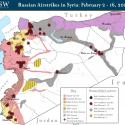 |
 |
Russian Airstrikes in Syria: February 2 - 16, 2016
Feb 16, 2016 - Genevieve Casagrande


Russia continues to target opposition forces and civilian infrastructure after brokering a “cessation of hostilities” agreement through the International Syrian Support Group (ISSG) on February 11. Russian air operations against the armed opposition have continued unhindered since the announcement of the agreement. Russian officials have reiterated that they have no plans to halt their air campaignagainst “terrorists,” which they have broadly defined to include all opposition groups threatening the Assad regime, including some receiving U.S. support. The “cessation of hostilities” agreement will ultimately leave Russian and other pro-regime forces free to continue anti-opposition operations throughout Syria. Meanwhile, aid organizations accused Russian warplanes of targeting four hospitals and one school in Aleppo and Idlib Provinces on February 15 alone. The reported attacks are a continuation of Russian targeting of vital civilian infrastructure, likely in an effort to soften the resolve of the Syrian armed opposition. Russia also has ratcheted up its military power in Syria since the agreement, with the deployment of the advanced Tu-214R intelligence, surveillance, and reconnaissance (ISR) aircraft to the Bassel al-Assad International Airport on February 15. The Tu-214R will likely work in coordination with the new Russian Su-35Swarplanes to conduct quick and accurate precision strikes. Its deployment is another indication that Russia and the regime continue to pursue a military solution to the conflict in Syria.
Russian-enabled Kurdish advances have applied additional pressure against opposition forces already strained by recent regime advances northwest of Aleppo City. Kurdish forces cleared over 10 kilometers of opposition-held terrain north of the city, seizing the town of Tel Rifaat, the Menagh Airbase, and at least five other villages from the armed opposition from February 6 - 16 with the assistance of Russian airstrikes. Given recent gains, Kurdish forces are positioned to seize the opposition stronghold of Mare’a located along the frontline with ISIS. Kurdish forces are also positioned to seize the town of Azaz located 10 kilometers south of Turkish border. Russian air support for Kurdish forces further escalates tensions with Turkey, which has responded to recent Kurdish gains by shelling recently seized villages adjacent to Azaz . Turkish officials called for the formation of a “secure strip” along Syria’s northern border with Turkey to protect the area from additional Kurdish advances on February 16, and have increasingly pressured the U.S. to cease support for Kurdish forces in the conflict.
The following graphic depicts ISW’s assessment of Russian airstrike locations based on reports from local Syrian activist networks, Syrian state-run media, and statements by Russian and Western officials. This map represents locations targeted by Russia’s air campaign, rather than the number of individual strikes or sorties.
High-Confidence reporting. ISW places high confidence in reports corroborated both by official government statements reported through credible channels and documentation from rebel factions or activist networks on the ground in Syria deemed to be credible.
Low-Confidence reporting. ISW places low confidence in secondary sources that have not been confirmed or sources deemed likely to contain disinformation.